menu
menu
Menu
cancel
- arrow_back_iosBacknavigate_nextperson_outlinePersonal
- add_taskService Board
- workJob Board
- swap_callsService Swap
- shopping_bagMarketplace
- handshakeProfessionals
- arrow_back_iosBacknavigate_nextlanguageSocial
- live_helpFAQ
